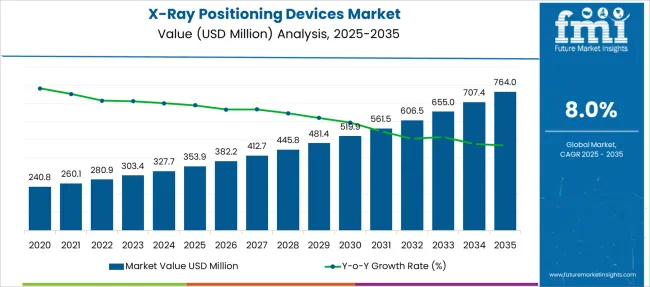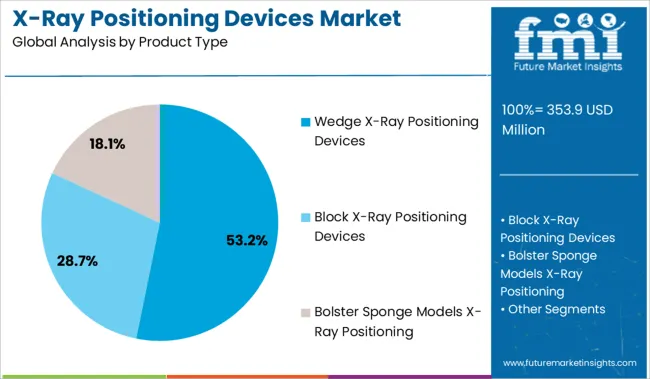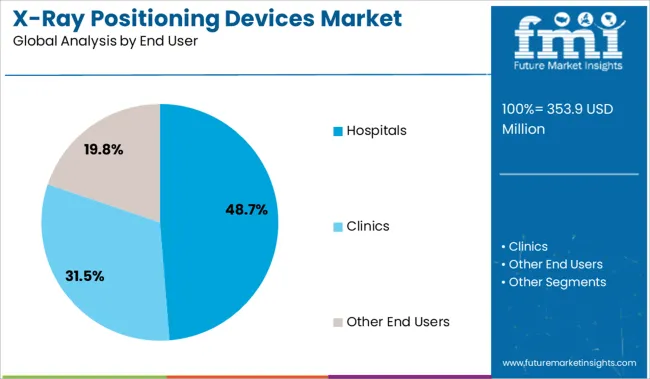The X-Ray Positioning Devices Market is estimated to be valued at USD 353.9 million in 2025 and is projected to reach USD 764.0 million by 2035, registering a compound annual growth rate (CAGR) of 8.0% over the forecast period.

| Metric | Value |
|---|---|
| X-Ray Positioning Devices Market Estimated Value in (2025 E) | USD 353.9 million |
| X-Ray Positioning Devices Market Forecast Value in (2035 F) | USD 764.0 million |
| Forecast CAGR (2025 to 2035) | 8.0% |
The X ray positioning devices market is gaining momentum due to increasing demand for precision imaging, rising diagnostic imaging volumes, and growing focus on patient safety during radiographic procedures. These devices support optimal patient alignment, reduce retakes, and enhance image quality, all of which contribute to operational efficiency in clinical settings.
The push for value based healthcare and the integration of ergonomic and radiolucent materials into device designs are improving both patient comfort and radiographer workflow. Advancements in diagnostic protocols, especially for orthopedic and trauma imaging, are also fueling product adoption.
With radiology departments under pressure to streamline throughput without compromising quality, the importance of accurate and repeatable patient positioning is being recognized as critical to diagnostic success. The outlook for this market remains strong, supported by technological improvements, regulatory emphasis on radiation safety, and expanding imaging infrastructure in both developed and emerging regions.
The market is segmented by Product Type and End User and region. By Product Type, the market is divided into Wedge X-Ray Positioning Devices, Block X-Ray Positioning Devices, and Bolster Sponge Models X-Ray Positioning. In terms of End User, the market is classified into Hospitals, Clinics, and Other End Users. Regionally, the market is classified into North America, Latin America, Western Europe, Eastern Europe, Balkan & Baltic Countries, Russia & Belarus, Central Asia, East Asia, South Asia & Pacific, and the Middle East & Africa.

The wedge X ray positioning devices segment is projected to account for 53.20% of total market revenue by 2025 under the product type category, making it the dominant segment. This is primarily due to its versatility across various imaging procedures including spine, abdomen, and limb positioning.
The angled design provides enhanced anatomical alignment, which significantly improves diagnostic accuracy while reducing patient repositioning and exposure time. Hospitals and imaging centers have increasingly integrated wedge devices into their radiographic protocols to improve efficiency and reduce motion artifacts.
Additionally, their lightweight, durable construction and compatibility with diverse patient demographics make them highly favored in routine diagnostics. The consistent ability to support correct posture and positioning without requiring manual adjustments contributes to the widespread adoption of this product type.

The hospitals segment is anticipated to hold 48.70% of the overall market revenue by 2025 within the end user category, establishing it as the leading segment. Hospitals represent the largest concentration of diagnostic imaging activities due to their comprehensive service offerings and high patient volumes.
The need for standardized imaging quality and compliance with radiation safety guidelines has led to increased deployment of positioning aids across radiology departments. These devices enhance diagnostic accuracy, support staff productivity, and contribute to better clinical outcomes by enabling consistent image acquisition.
With hospitals continuing to invest in advanced imaging infrastructure and emphasizing workflow optimization, their reliance on positioning devices is expected to remain dominant across all geographic regions.
One of the major causes of the rising number of diagnostic imaging tests conducted globally is the increasing burden of chronic illnesses. For example, the World Health Organization (WHO) estimates that roughly 65 Million individuals worldwide have the chronic obstructive pulmonary disease (COPD).
The demand for x-ray positioning devices is rising as many doctors primarily demand chest x-rays of patients to diagnose heart issues. As a result, the prevalence of these disorders is rising, increasing the need for effective and affordable diagnostic equipment like x-ray positioning devices.
The expansion of the market is linked to affordable services, supplies, skilled labor, and equipment as compared to other settings, such as hospitals. Diagnostic imaging centers are progressively implementing x-ray positioning devices. As a result, the market is projected to be driven by both the increased adoption of x-ray positioning devices in these centers for early diagnosis and the slow but steady growth of these diagnostic imaging centers in different nations.
The regular introduction of cutting-edge x-ray positioning devices aids is anticipated to affect market dynamics from 2025 to 2035. The demand for x-ray positioning devices is growing as better imaging technologies are developed.
Growing numbers of independent radiography clinics in developing nations are projected to stimulate the industry. Rising collaboration among players and suppliers to broaden their reach is anticipated to have an impact on the penetration and accessibility of x-ray positioning devices.
Additionally, the market for x-ray positioning devices is projected to be stimulated throughout the forecast period due to the rising availability of positioning and radiology courses.
X-Rays can be used to detect not only bone fractures but also various forms of cancers, tumours, digestive issues and infections. High frequency of lung cancer around the world due to smoking and/or Air pollution is expected to spur the demand for the X-Ray positioning devices market.
New advancements in X-Ray technology also enable early detection of breast cancer, tumours or other infections. This encourages people to undergo an X-Ray to be able to start the treatment early (if required), thereby boosting the X-Ray positioning devices market as well.
As with all aspects of science, even the field of medicine is rapidly evolving. Point of care diagnostics to determine what is afflicting a patient has improved tremendously and provides far more insight to a doctor today with the help of modern day technology.
This has made the need to undergo an X-Ray limited to only severe cases like head trauma (for an MRI or CT scan) or any other kind of serious issue. This also restrains the growth of the X-Ray positioning devices market. Some positioning devices like sandbags may contain ferromagnetic shavings or iron pellets which can damage MRI scanners or even injure the radiologist or patients in the worst case scenario.
There are several studies which show that X-Ray equipment is all too often overused by medical centres. Insurance agencies have begun to refuse reimbursement in several cases which reduces the motivation for these clinics to invest in expensive X-Ray technology.
This also reduces the chance of them requiring equipment sold in the X-Ray positioning devices market.
North America is the largest X-Ray market at present and is thereby also the largest X-Ray positioning devices market. The demand in this region is from both hospitals as well as private clinics. In addition to this, the introduction of handheld X-ray devices has also spurred the demand for X-ray positioning devices.
The patients requiring an X-Ray in this part of the world are usually (but not always) of an older age group due to the population structure. In Asia and Africa, there is a larger proportion of people below the age of 30 i.e. a younger demographic.
Children in countries like China, India, Thailand or even African nations like Kenya, Nigeria and South Africa might frequently injure themselves while playing or even fracture a limb unfortunately. So manufactures would do well to market their products targeted at youth in the Asia Pacific or African X-Ray positioning devices market.

Some manufacturers involved in the X-Ray positioning devices market are Z & Z medical, Cone instruments, Merry X-Ray, Universal Medical Inc, and Clear Image Devices.
The research report presents a comprehensive assessment of the market and contains thoughtful insights, facts, historical data, and statistically supported and industry-validated market data. It also contains projections using a suitable set of assumptions and methodologies.
The research report provides analysis and information according to market segments such as geographies, types and applications.
The global x-ray positioning devices market is estimated to be valued at USD 353.9 million in 2025.
The market size for the x-ray positioning devices market is projected to reach USD 764.0 million by 2035.
The x-ray positioning devices market is expected to grow at a 8.0% CAGR between 2025 and 2035.
The key product types in x-ray positioning devices market are wedge x-ray positioning devices, block x-ray positioning devices and bolster sponge models x-ray positioning.
In terms of end user, hospitals segment to command 48.7% share in the x-ray positioning devices market in 2025.






Full Research Suite comprises of:
Market outlook & trends analysis
Interviews & case studies
Strategic recommendations
Vendor profiles & capabilities analysis
5-year forecasts
8 regions and 60+ country-level data splits
Market segment data splits
12 months of continuous data updates
DELIVERED AS:
PDF EXCEL ONLINE
Backscatter X-ray Devices Market Size and Share Forecast Outlook 2025 to 2035
Digital Mobile X-ray Devices Market Analysis - Growth & Forecast 2024 to 2034
Repositioning and Offloading Market – Trends & Forecast 2024 to 2034
Repositioning & Offloading Devices Market – Demand & Forecast 2024 to 2034
Spine Positioning Devices Market
Infant Positioning Aids Market Size and Share Forecast Outlook 2025 to 2035
Global Positioning Systems Market Size and Share Forecast Outlook 2025 to 2035
Dynamic Positioning System Market Size and Share Forecast Outlook 2025 to 2035
Patient Positioning Equipment Market Size and Share Forecast Outlook 2025 to 2035
Patient Positioning System Analysis by Product Type and by End User through 2035
Seating And Positioning Belts Market Size and Share Forecast Outlook 2025 to 2035
Assured PNT (Positioning, Navigation, and Timing) Market Size and Share Forecast Outlook 2025 to 2035
Radiotherapy Positioning Devices Market Size and Share Forecast Outlook 2025 to 2035
Pedicle Screw Positioning Market Analysis - Size, Share, and Forecast Outlook 2025 to 2035
Radiotherapy Patient Positioning Accessories Market Trends – Forecast 2025 to 2035
Navigation, Imaging and Positioning Solutions Market - Trends & Forecast 2025 to 2035
Automotive High Precision Positioning Market Size and Share Forecast Outlook 2025 to 2035
Europe Radiotherapy Patient Positioning Market Size and Share Forecast Outlook 2025 to 2035
Ultra Short Base Line (USBL) Positioning Systems Market Size and Share Forecast Outlook 2025 to 2035
FBAR Devices Market

Thank you!
You will receive an email from our Business Development Manager. Please be sure to check your SPAM/JUNK folder too.
Chat With
MaRIA